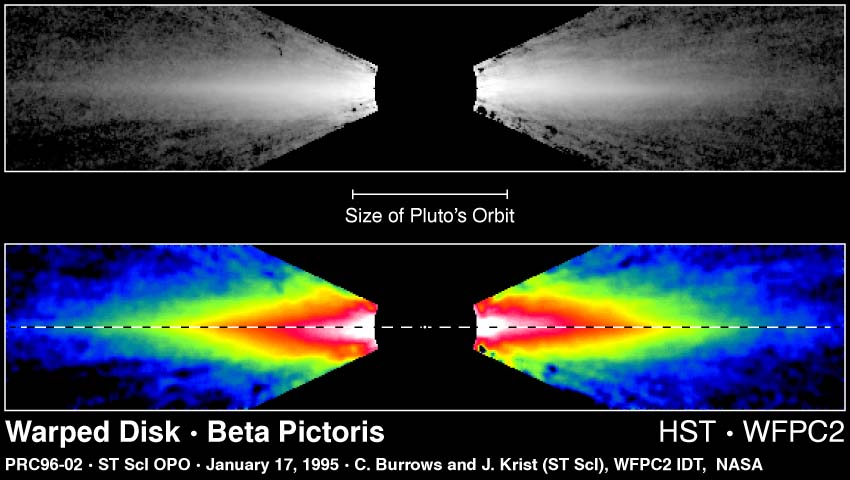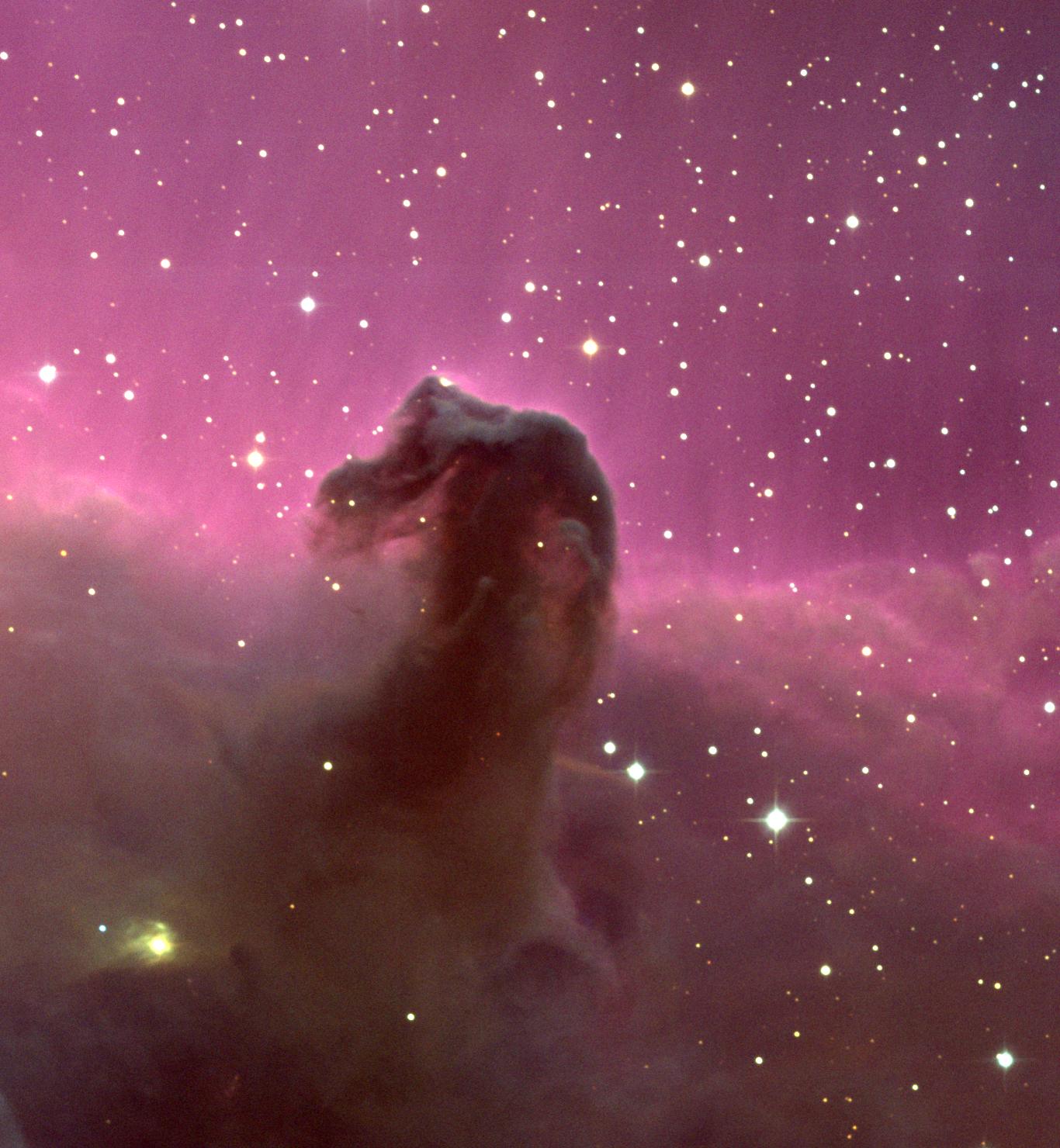-
 Planetary nebula Cat's Eye from HST.
Planetary nebula Cat's Eye from HST.
The Cat's Eye is about 3000 lyr away in constellation Draco. It is one of the most complex of planetary nebula and is estimated to be only about 1000 years old. The green color is due to green forbidden lines of O III (i.e., twice ionized oxygen).
Credit: NASA: Imagine the Universe.
-
 The Ring Nebula from HST. The best known of all planetaries.
The Ring Nebula from HST. The best known of all planetaries.
The Ring Nebula is about 2000 lyr away in constellation Lyra. The ring is about 1 lyr in diameter. The green color is due to green forbidden lines of O III (i.e., twice ionized oxygen). The blue is from helium and the red color is from ionized nitrogen.
Credit: NASA: Imagine the Universe.
-
 Atomic spectra for stellar spectroscopic analysis.
Atomic spectra for stellar spectroscopic analysis.
Credit: NASA: Imagine the Universe.
-
 Making an absorption line spectrum.
Making an absorption line spectrum.
Credit: NASA: Imagine the Universe.
-
 Beta Pictoris and its famous disk.
Beta Pictoris and its famous disk.
Beta Pictoris (Betapic) is second brightest star in the visual in the southern constellation Pictor: see the Munich Astro Archive on constllation Pictor.
Betapic is about 50 lyr away.
Since 1983, Betapic has been known to have a disk of gas and dust and it has been suspected that planets are forming in or even have formed from the disk. The discovery of the disk was a crucial confirmation of the disk aspect of the star formation process.
The disk is visible in visual and infrared: it starts about 50 AU from the star and extends to at least 2000 AU. Inside 50 AU is a clear region.
This HST image (the star and clear region are artificially occulted) shows the disk.
We see the disk almost exactly edge-on. It is of order 10 AU thick.
The image is from the visual and shows reflected light. The top view is just a simple image, I think.
The bottom view is in false color to show the intensity of the reflected emission.
The slight tilt near the inner edge of the disk from the mean disk plane (shown by a dashed line) suggests that planets have formed in clear region and they perturb the disk. (FMW-409).
See also SEDS on Betapic
Credit: NASA.
-
 The three pillars of dust-laden gas in the Eagle Nebula from HST.
The three pillars of dust-laden gas in the Eagle Nebula from HST.
The Eagle nebula is star forming region about 7000 lyr away in the constellation Serpens.
The image is false color. Red shows emission from singly-ionized sulfur atoms. Green shows emission from hydrogen. Blue shows light emitted by doubly- ionized oxygen atoms.
The pillars protrude from a molecular cloud below them: the tallest is about 1 lyr long.
Above them and off the image are hot young stars that formed at an earlier epoch. Those young stars emit UV radiation that is evaporating the pillars.
The pillars contain small DENSE CORES that are being exposed: they stand out as dangling globules from the pillars. In some of these globules are new or forming stars that will appear when the dust and gas globules are evaporated.
Near the lower left of the center region there is a dangling globule that appears to have newborn star emerging.
Credit: NASA.
-
 The Eagle Nebula from NOAO, Kitt Peak, Arizona.
The Eagle Nebula from NOAO, Kitt Peak, Arizona.
The Eagle nebula is star forming region about 7000 lyr away in the constellation Serpens.
The image is a mosaic in false color from emission line images: hydrogen-alpha (green), oxygen [O III] (blue) and sulfur [S II] (red). H alpha should be red and I imagine that [O III] should be green.
The famous THREE PILLARS from the HST image are in the center.
Note that one has bright emission gas clouds heated by newly formed hot young stars that are evaporating the dust in the dark dusty clouds where star formation continues.
Credit: T.A.Rector (NRAO/AUI/NSF and NOAO/AURA/NSF) and B.A.Wolpa (NOAO/AURA/NSF).
-
 A section of the Orion Nebula with proplyds from HST.
A section of the Orion Nebula with proplyds from HST.
The Orion nebula is in sword of Orion about 1,500 lyr away. It is the most conspicuous star formation region on the sky. Star formation occurs in clouds of gas and dust.
This image is about 2.5 lyr wide and is only a small section of the nebula.
Hot young, massive stars are dispersing this part of the nebula and making it bright rather than dark via reflection and induced emission. The dispersal tends to turn off star formation. Star formation is compicated by these complex feedback mechanisms. In particular note the 4 Trapezium stars near the center.
Proplyds are protoplanetary disks around youngs stars. In the image there are more than about 150 of them.
The obvious ones are near the Trapezium and have tails. Light pressure from the Trapezium is blowing away some of the gas and dust that forms the proplyds.
True color? False color? The official caption doesn't tell, but I assume that the colors have been enhanced to bring out details even if they are more or less true.
Credit: NASA: image #PR95-45A.
 The Horsehead Nebula from NOAO, Kitt Peak, Arizona.
The Horsehead Nebula from NOAO, Kitt Peak, Arizona.
The Horsehead Nebula because of its accidental resemblance to a horse's head is one of the most famous of all nebulae.
This is approximately a true color image. The Horsehead Nebula is a dark dusty nebula. The difference in star counts above and below the mid-image line illustrates that no or few stars are seen through the dark nebula: most of the stars in the lower image are probably foreground.
The pink color is an emission nebula. Ultraviolet light from hot young stars creates excited hydrogen atoms which then emit strongly in the hydrogen red line (i.e., the H alpha line).
-
[The excitation is usually accomplished by ionization of hydrogen
followed by recombination to an excited level.]
Credit: N.A.Sharp/NOAO/AURA/NSF.